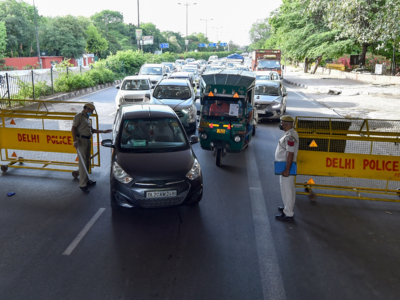
NEW DELHI: As parts of India stirred to life on Monday amid a conditional easing of the lockdown, confusion prevailed in Delhi and NCR on how to regulate the surge of people and traffic caused by absence of clarity on aspects such as who among the junior central government workforce would constitute one-third of the office turnout allowed on a given day.
The attendance conundrum compelled police to permit movement solely on the basis of employee identity cards, resulting in even those not supposed to attend office moving around freely.
Traffic in the New Delhi Municipal Council area and on roads along the CGO complex, where most central government offices are located, was heavier than expected despite strict checking at multiple points.
More on Covid-19
Delhi Police's special branch had issued a circular on Sunday, saying "all central government employees be permitted on the basis of their identity cards".
Although rosters have been made, officials said non-biometric attendance had made it possible for senior officials to "make informal arrangements without compromising on safety and other guidelines". Things will be streamlined in next couple of days, they said.
In Gurgaon, classified as a Covid-19 "red zone", there was some chaos at NHAI project sites after workers gearing up to resume work were stopped by police. The NHAI had asked its contractors to resume work on Monday with whatever workforce was available at these sites, subject to compliance with Union home ministry guidelines on social distancing and other safety protocols. Police officials, however, said separate permission was required from the administration since Gurgaon was in the red zone.
UP appeared to handle the first-day challenges better, with several road projects like the Purvanchal, Bundelkhand and Gorakhpur Link expressways resuming after almost a month. The state government has lifted curbs on 11 industries for now. "The government is ensuring that all labourers brought for work are medically screened," a senior government official said.
In Mumbai, the entire Thane district being declared a containment zone on Sunday ensured that all Maharashtra Industrial Development Corporation (MIDC) estates spread across Thane, Navi Mumbai, Kalyan-Dombivali, Ambernath and Murbad remained shut on Monday.
Raigad district, where the Taloja industrial estate is located, saw mainly industries producing medicines and packaging material being permitted to open. Around 35 units have been granted permission to resume operations.
In the rest of Maharashtra, 1,335 units employing 20,000 workers have been granted permission to operate. Around 3,000 had registered for permission.
Across Kerala – in Thiruvananthapuram, Kottayam, Idukki, Thrissur, Palakkad, Alappuzha and Wayanad districts, all of them classified as either "green" or "orange" zones – lockdown rules were eased for businesses to breathe again. But with the Centre advising the state government against an all-out resumption, the buzz seemed to die down just as quickly. Restaurants that had been allowed to resume dine-in from Monday were hastily shut. Salons met the same fate.
Police sources said there was also confusion over the odd-even rule for vehicles. While the rule was implemented in the rural belt, vehicles were prevented from entering city limits, triggering the first snarls in almost four weeks in areas bordering the state capital.
In Bhubaneswar, offices reopened after a month in 20 districts, barring the hotspots. But getting back to work was not quite the same, with masks and a minimum distance of six feet between two people being made mandatory. For meetings, the limit was 10 people in a room. IT and ITES companies started work with a maximum of 50% of their workforce
Dillip Jena, a building contractor who resumed work on his project in Gajapati district, said, "With fewer workers and materials not readily available, it will take some time for the situation to become normal. We needed 50 labourers on Monday, but had to start with 11."
Lockdown restrictions remained in force in Bhubaneswar, except in government offices. The capital city is a Covid-19 hotspot with 46 cases so far. "Returning to office gave me the feeling that things are slowly returning to normal, although there were few people on the roads and everything except our offices was shut," said Kaveri Dhar, an employee of the revenue department.
Gujarat, which is battling a surge in Covid-19 infections, allowed 6,000-odd industrial units to resume functioning. According to the labour and employment department, all these units are located outside the limits of municipal corporations and municipalities.
The attendance conundrum compelled police to permit movement solely on the basis of employee identity cards, resulting in even those not supposed to attend office moving around freely.
Traffic in the New Delhi Municipal Council area and on roads along the CGO complex, where most central government offices are located, was heavier than expected despite strict checking at multiple points.
More on Covid-19
Delhi Police's special branch had issued a circular on Sunday, saying "all central government employees be permitted on the basis of their identity cards".
Although rosters have been made, officials said non-biometric attendance had made it possible for senior officials to "make informal arrangements without compromising on safety and other guidelines". Things will be streamlined in next couple of days, they said.
In Gurgaon, classified as a Covid-19 "red zone", there was some chaos at NHAI project sites after workers gearing up to resume work were stopped by police. The NHAI had asked its contractors to resume work on Monday with whatever workforce was available at these sites, subject to compliance with Union home ministry guidelines on social distancing and other safety protocols. Police officials, however, said separate permission was required from the administration since Gurgaon was in the red zone.
UP appeared to handle the first-day challenges better, with several road projects like the Purvanchal, Bundelkhand and Gorakhpur Link expressways resuming after almost a month. The state government has lifted curbs on 11 industries for now. "The government is ensuring that all labourers brought for work are medically screened," a senior government official said.
In Mumbai, the entire Thane district being declared a containment zone on Sunday ensured that all Maharashtra Industrial Development Corporation (MIDC) estates spread across Thane, Navi Mumbai, Kalyan-Dombivali, Ambernath and Murbad remained shut on Monday.
Raigad district, where the Taloja industrial estate is located, saw mainly industries producing medicines and packaging material being permitted to open. Around 35 units have been granted permission to resume operations.
In the rest of Maharashtra, 1,335 units employing 20,000 workers have been granted permission to operate. Around 3,000 had registered for permission.
Across Kerala – in Thiruvananthapuram, Kottayam, Idukki, Thrissur, Palakkad, Alappuzha and Wayanad districts, all of them classified as either "green" or "orange" zones – lockdown rules were eased for businesses to breathe again. But with the Centre advising the state government against an all-out resumption, the buzz seemed to die down just as quickly. Restaurants that had been allowed to resume dine-in from Monday were hastily shut. Salons met the same fate.
Police sources said there was also confusion over the odd-even rule for vehicles. While the rule was implemented in the rural belt, vehicles were prevented from entering city limits, triggering the first snarls in almost four weeks in areas bordering the state capital.
In Bhubaneswar, offices reopened after a month in 20 districts, barring the hotspots. But getting back to work was not quite the same, with masks and a minimum distance of six feet between two people being made mandatory. For meetings, the limit was 10 people in a room. IT and ITES companies started work with a maximum of 50% of their workforce
Dillip Jena, a building contractor who resumed work on his project in Gajapati district, said, "With fewer workers and materials not readily available, it will take some time for the situation to become normal. We needed 50 labourers on Monday, but had to start with 11."
Lockdown restrictions remained in force in Bhubaneswar, except in government offices. The capital city is a Covid-19 hotspot with 46 cases so far. "Returning to office gave me the feeling that things are slowly returning to normal, although there were few people on the roads and everything except our offices was shut," said Kaveri Dhar, an employee of the revenue department.
Gujarat, which is battling a surge in Covid-19 infections, allowed 6,000-odd industrial units to resume functioning. According to the labour and employment department, all these units are located outside the limits of municipal corporations and municipalities.
Download
The Times of India News App for Latest Business News
Subscribe
Start Your Daily Mornings with Times of India Newspaper! Order Now
more from times of india business
Quick Links
ELSS Mutual Funds BenefitsIncome Tax Refund statusWhat is AssochamITR Filing Last DateHome Loan EMI TipsHome Loan Repayment TipsPradhan Mantri Awas YojanaTop UP Loan FeaturesIncrease Home Loan EligibilityHome Loan on PFTax Saving Fixed DepositLink Aadhaar with ITRAtal Pension YojanaNita AmbaniIndian EconomyRBIAadhaar CardSBIReliance CommunicationsMukesh AmbaniIndian Bank Ifsc codeIDBI Ifsc codeIndusind ifsc codeYes Bank Ifsc CodeVijay Bank Ifsc codeSyndicate bank Ifsc CodePNB Ifsc codeOBC Ifsc codeKarur vysya bank ifscIOB Ifsc codeICICI Ifsc codeHDFC Bank ifsc codeCanara Bank Ifsc codeBank of baroda ifscBank of America IFSC CodeBOM IFSC CodeAndhra Bank IFSC CodeAxis Bank Ifsc CodeSBI IFSC CodeGST
Get the app








